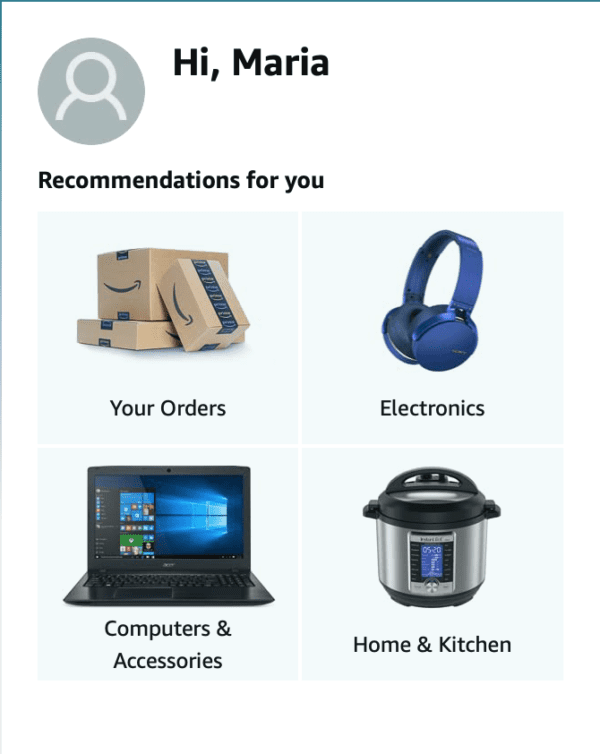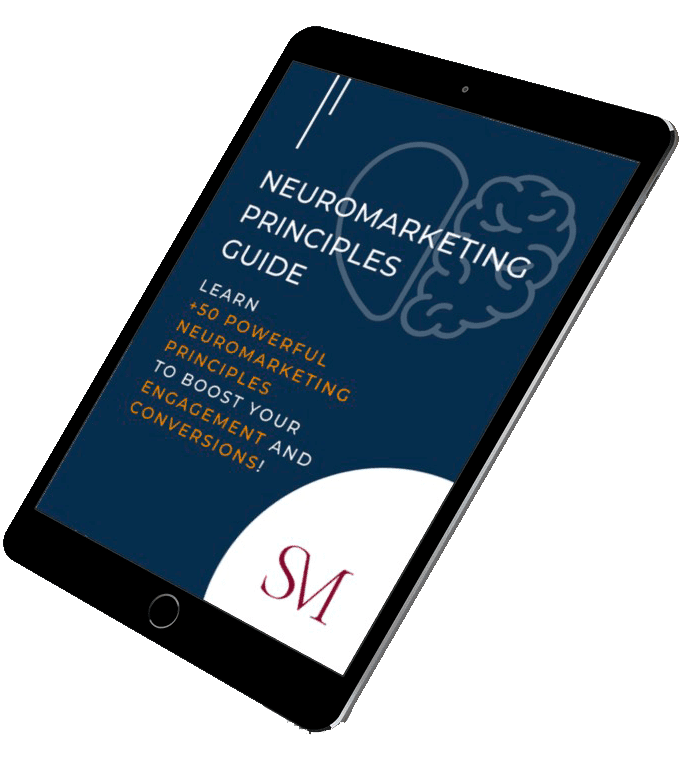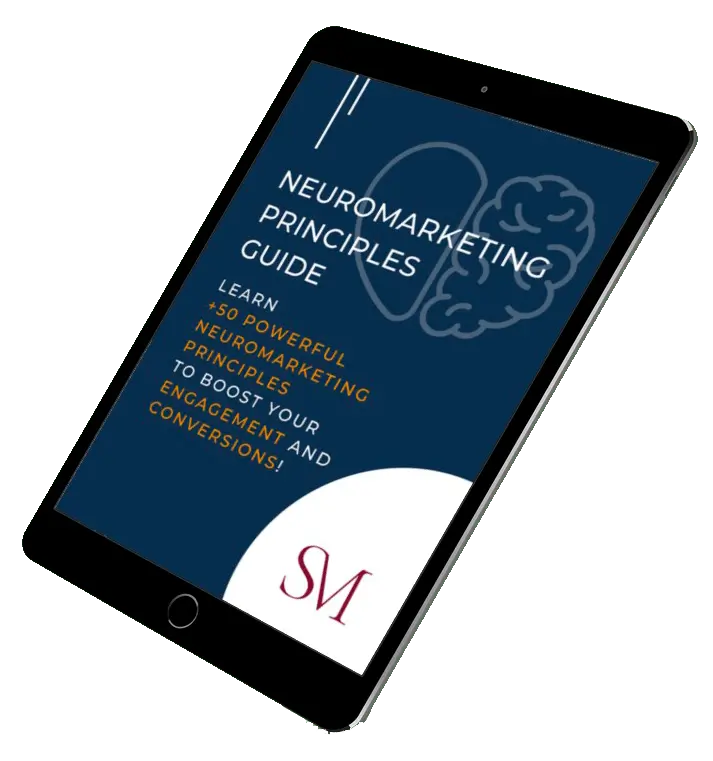
Big established businesses know very well what they are doing.
There is no surprise then if they are able to keep their standards and continue growing.
They understand and know that business growth comes from having an efficient strategy based on deep market and target audience’s knowledge.
It’s simple.
The more you know about the market you want to compete in and your target audience, the more detailed and effective your digital marketing strategy becomes.
Psychology science is something that, under this perspective, big businesses don’t leave on the table.
They actually use it to empower their strategy and communication through principles that, once applied to marketing, give it the name of Neuromarketing.
In this article, we want to walk you through the way Amazon uses Neuromarketing to stimulate their potential customers’ emotional decision system and have one of the highest online conversion rates.
But first, let’s quickly see what Neuromarketing is.
Neuromarketing is a commercial marketing communication area that applies neuropsychology to market research, studying consumers’ sensorimotor, cognitive, and affective response to marketing stimulations.
Neuromarketing attempts to understand the rationale behind how consumers make purchasing decisions and their responses to marketing stimulations to apply those learnings to empower marketing.
The potential benefits to businesses include more efficient and effective marketing campaigns and strategies, fewer product and campaign failures, and ultimately an emotional customer engagement that leads a high percentage of them to trust and love the business.
So, this basically means planning a strategy based on the behavioural patterns your ideal clients have and the emotions they experience, leading your marketing to be much more efficient.
This means not simply promoting your products or services but empathising with your audience, leading them to feel secure about the choice of picking your business over your competitors’.
However, bear in mind, to get the most out of your Neuromarketing efforts, you must first complete a deep analysis of your target audience.
This is crucial if you want to efficiently use Neuromarketing.
That’s because, if you get to uncover your ideal clients inner behavioural patterns and emotions, you will be able to select the best Neuromarketing techniques for them and achieve higher results in terms of engagement, interaction, and conversions.
Neuromarketing is designed to stimulate people emotionally and drive them to behave in a specific way.
Therefore, if you know the right emotions and behavioural patterns that positively influence their purchase decision making, your digital marketing strategy will lead your business to high engagement and conversion rate.
On the other hand, if you don’t know them and stimulate the wrong emotions and behavioural patterns, your marketing will lead your business to a high bounce rate and low conversions.
If you want to know how to make a deep audience analysis, getting to know your target audience at a deeper level, click here to see our full audience analysis guide.
Types of Neuromarketing
There are several different types of neuromarketing techniques that are used to study consumer behavior and improve the effectiveness of advertising campaigns. Some of the most common types of neuromarketing include:
- Eye-tracking: This technique uses a specialized camera to track the movement of a consumer's eyes as they view an advertisement or product, providing insights into which elements of the ad are most effective in attracting attention.
- Functional Magnetic Resonance Imaging (fMRI): This technique uses a specialized machine to measure changes in blood flow to different regions of the brain, providing insights into which emotions and thoughts are triggered by different aspects of an advertisement.
- Electroencephalography (EEG): This technique uses a specialized headset to measure electrical activity in the brain, providing insights into the level of attention and engagement a consumer has with an advertisement.
- Galvanic Skin Response (GSR) : This technique measures the electrical conductance of the skin, providing insights into consumer's emotional response to an advertisement.
- Pupilometry: This technique measures changes in the size of the pupil of the eye, providing insights into consumer's emotional response to an advertisement.
- Facial coding: This technique records and analyzes facial expressions to understand consumer's emotional response to an advertisement.
These techniques can be used to understand consumer behavior at a deeper level, and can help advertisers create more effective and engaging campaigns.
What are neuromarketing strategies?
Neuromarketing strategies refer to the specific methods and techniques that companies use to apply the principles of neuromarketing in their advertising campaigns. Some examples of neuromarketing strategies include:
- Using eye-tracking to identify the most effective elements of an advertisement or product design.
- Using fMRI or EEG to understand the emotional and cognitive responses that consumers have to different aspects of an advertisement, such as the colors, images, and text used.
- Using GSR or Pupilometry to understand consumer's emotional response to an advertisement and the level of engagement.
- Using facial coding to understand consumer's emotional response to an advertisement, and to identify the elements that are most likely to trigger positive or negative emotions.
- Using personalization and targeting to deliver advertisements that are tailored to the specific preferences and interests of individual consumers.
- Creating a brand story that appeals to consumer's emotions and creates an emotional connection.
- Using neuro-linguistic programming techniques to craft the language and wording of advertisements in a way that is most likely to resonate with consumers.
- Using neuro-pricing strategies to understand how different prices affect consumer's purchasing decisions.
Neuromarketing strategies are designed to use the insights provided by neuroscientific techniques to create more effective and engaging advertising campaigns that connect with consumers on an emotional level.
Benefits of using Neuromarketing for a business
There are several benefits that a business can gain from using neuromarketing techniques in their advertising campaigns:
- Improved effectiveness: Neuromarketing allows businesses to understand consumer behavior at a deeper level, which can help them create more effective and engaging advertising campaigns. By understanding which elements of an advertisement are most likely to attract attention and trigger positive emotions, businesses can create more effective ads that resonate with consumers.
- Increased return on investment: By creating more effective advertising campaigns, businesses can achieve a higher return on investment for their advertising spend.
- Personalization: Neuromarketing techniques, such as targeted advertising, allow businesses to deliver personalized advertisements to individual consumers based on their preferences and interests. This can help to increase engagement and conversion rates.
- Branding: By understanding the emotional response of consumers to different elements of their brand, businesses can create a strong and consistent brand that resonates with consumers on an emotional level.
- Increased customer loyalty: By creating an emotional connection with consumers, businesses can increase customer loyalty and reduce customer churn.
- Better product design: Neuromarketing techniques can be used to understand how consumers interact with products, which can help businesses to design products that are more appealing and user-friendly.
- Price optimization: Neuromarketing techniques can be used to understand how different prices affect consumer's purchasing decisions, which can help businesses to optimize pricing strategy.
Neuromarketing can provide businesses with valuable insights into consumer behavior and help them to create more effective and engaging advertising campaigns that increase return on investment, boost customer loyalty, and improve product design.
So, now that you know what Neuromarketing is and why it is essential to create an efficient digital marketing strategy, let’s see how Amazon uses it to be the biggest online retailer.
Amazon Leverages Neuromarketing to Increase Sales
3 are the main Neuromarketing techniques Amazon uses to have high engagement and conversion rate.
Amazon Neuromarketing Technique 1 – Personalised User Layout
When you land on Amazon’s website, you can immediately notice there are product images everywhere.
This extremely visual layout is designed to catch people’s attention and make things as easy as possible for a better user experience.
In particular, when everything looks clear and straight forward, people feel more secure about what is happening on the page they lant as things are easy to understand.
And this induces them to predominantly use the emotional system for decision making – meaning that they are going to be more receptive to the neuropsychological stimulations used through the pages.
If then you have used the Amazon website previously, you will also notice something else. Amazon tracks every visitor’s browsing and purchases on its website.
This way, they create a personalised profile for each customer.

Every page, including the home page, is unique in design for each customer.
Depending on what you searched or purchased previously, Amazon will show you specific recommendations.
Just for you.
Just because you needed those items in the past.
Also, if you previously purchased an item, Amazon create a unique account with your name alongside the recommendations they have for you.
This way, you will feel like they are talking specifically for you. They are basically adapting the whole website to your needs, making you feel very special.
This psychological principle is called Singularity Effect, and it leverages the tendency most people have to mainly engage with something that makes them feel identified and special.
When people search for products or services, they search for solutions to the problems they have been experiencing.
So, before spending money on something, they want to make sure they are in the right place, and they are going to purchase the right thing for them to fix those problems.
And here is the key; for them to fix their problems.
This is why personalising the website and speaking directly to them is so powerful.
It makes them feel identified and understood, with the effect of making them trust they are in the right place.
Personalization is one of Amazon’s keys to success.
They speak directly to you and fully optimize every customer’s experience.
Identification with customers is a powerful Neuromarketing tactic.
Amazon Neuromarketing Technique 2 – Highly Recommended Item Options
No two visitors have the same shopping habits.
This means that there are nearly endless ways to shop. You can either search for items by typing their names, check the multiple categories, or follow Amazon’s specific suggestions.
No matter the way you decide to shop, Amazon will show you curated lists of products, specifically presented to match your previous choices and needs.
The website also provides comparisons with other similar products and the most relevant items to drive you to buy.
One of the most used psychological principles that Amazon uses in this sense is the Dragging Effect.
The Dragging Effect is the tendency that most people have to do or think the same that other people already do.
Another way to name this principle is Social Proof.
So, what does Amazon do?
For each product presented, they show you stars and other users’ opinions, creating a feeling of security in those looking for those products. This basically makes you feel more comfortable with your choice, positively influencing potential customers’ decision-making.
This induces their target audience to think that it is a safe choice to purchase the product they offer you.

In the image, you can notice the star reviews, alongside the number of people who purchased the item and left their high opinion about it.
Of course, Amazon shows and recommends the products with the highest number of positive reviews.
And they mainly do it for 2 reasons: better user experience and induce you to buy.
If there is something that Amazon cares a lot about is to provide the best experience to their customers.
In fact, they also have very strict rules for vendors to meet a high standard and guarantee a great customer experience.
This way, if a vendor wants to be on the first page and be recommended by Amazon and increase their sales with it, they will need to guarantee great quality products and customer experience.
This way, while they ensure great standards, they make sure their customers get the best options for them to feel satisfied with their purchase and come back to the website again in the future.
All this induces a feeling of security in the potential customers who ultimately feel they can trust the choice.
And it’s exactly this feeling that leads a high number of users to convert into loyal clients.
Another way they do it is by showing on the top of the listing or in the recommended items those products with special banners.
We are sure that if you used the Amazon website, you know what badges we are talking about.
These are the “Amazon Prime” and “Amazon Choice” badges.
Both badges use words that stimulate the idea that the products that have them are somehow the highest standard of the ones listed.
In particular, the “Amazon Choice” badge generates a thought like: “Oh if this is the Amazon choice, it must be the best one among the listed ones. Let me check it out!”
And just because people believe that item is the best one, they will most likely feel like they don’t need to check other products as they won’t be as good.
And just like this, the goal of converting users in the quickest time possible is accomplished.
For the “Amazon Prime” badge, apart from the words used, the main impact is the benefit of not just getting an item with a high rate but the possibility to have it delivered the following day.
That’s a great benefit.
Things that help people achieve their goals better and in the quickest time have the highest conversion rate.
And this is the pain point Amazon wants to press with this and give a solution to.
The goal of all these product list techniques is to drive users to click on a product to view its detail page, which is where they can finalise their purchase.
Alright, now before we move on with the next neuromarketing strategy Amazon uses for higher engagement and conversions, have you ever thought about how many neuromarketing principles you could use to generate constant business growth? Get for Free our Neuromarketing Principles Guide to learn +50 technithes you can implement into your marketing strategy for higher visibility, engagement, and profit.
Learn +50 Powerful Neuromarketing Principles to Boost Your Engagement and Your Conversions

Amazon Neuromarketing Technique 3 – Highly Stimulating Purchase Box
As Amazon is an online retailer, its goal is to convert through a click to add a product to the shopping cart or make an instant purchase.
Their product detail pages achieve this goal brilliantly with the help of Neuromarketing techniques.
For example, the image below shows a typical purchase box on a product detail page.


Here, we can notice multiple Neuromarketing techniques.
The first one, probably the most evident one, is the use of the words “FREE shipping” that we can see twice.
The use of these words sounds in users brains like Amazon is doing them a favour, giving them something for free – the shipping – in exchange for purchasing the item.
And, most people have a tendency to feel grateful when they receive favour from someone, potively predisposing them towards the purchase.
The box also stimulates the Scarcity cognitive bias, which is the tendency to value more those opportunities, contents, or products/services which are rare or seem to be a small number.
They do it by stressing a short amount, increasing the feeling of “if you don’t do it now, you might not be able to do it later as we are running out of this item.”
This technique is very powerful when one of the main driving emotions of your target audience is a fear of missing out or the anxiety of fixing their problems as soon as possible.
The order box is also personalised.
As you can see, here as well, Amazon mentions the customer’s name, creating an even bigger feeling of unicity and specialty.
They do it to empower the rest of the techniques used and to create a continuity with the strategies used in the previous steps.
This way, when everything follows a line, everything stays clear and easy to understand, increasing even more the predisposition to be positively impacted by the rest of the neuromarketing principles and don’t leave the website empty handed.
Finally, they offer different purchase choices to their shoppers.
They can order immediately or add the product to the shopping cart and continue shopping.
Either way, the visitor is driven toward a purchase decision, using indirect suggestions designed specifically to promote their conversion.
Marketing and Psychology Meet at Amazon
Amazon’s website is optimised for the highest product sales by applying the right Neuromarketing principles for their target audience.
With professional psychologists and neuro-marketers on their staff, Amazon constantly tests and implements brain-aware strategies in their marketing.
How can you implement the right Neuromarketing techniques in your marketing strategy?
As you read here about Amazon’s Neuromarketing techniques, you can understand more about why they have such a high conversion rate and how neuromarketing works.
You understand how the psychological aspect of communication – digital or not – is crucial if you want to stand out and achieve higher results.
Now, the techniques presented in this article are the ones Amazon uses the most to generate a high number of sales.
You may want to try these techniques along your sales funnel, and you’ll surely see improvements.
But if you want to get the most out of using Neuromarketing and truly set your business up for constant growth, you’ll want to first deeply analyse your audience and then use the right techniques for them.
You can click here to read our full Audience Analysis Guide and get to see how to uncover your ideal clients’ inner driving emotions and purchase motivations.
Learn +50 Powerful Neuromarketing Principles to Boost Your Engagement and Your Conversions



Each technique is good in stimulating specific emotions and behaviours.
It’s all about getting to know what emotions and behaviours it’s best to stimulate to drive your ideal clients through the steps of your sales funnel.
Bear with us a few weeks as we are going to launch a new Neuromarketing Guide with more than 50 techniques you can implement and use for higher engagement and sales.
If you’d like to get a copy, text us in chat, and we’ll give you access as soon as it’s ready!
If, instead, you feel that applying the right concepts on your own to your company and empower your marketing as Amazon does isn’t that easy, or you simply don’t have the time to do it, you can contact SM Agency.
We are Neuromarketing experts.
How can we help you implement effective Neuromarketing techniques for higher visibility and sales?
SM Agency is considered a leading neuro digital marketing agency London brands can benefit the most from for powerful marketing strategies. Everything we do for our clients is based on proven psychology and neuroscience research.
We rely on the latest tech innovations and partner with cutting-edge data providers like AeMotion to precisely uncover audiences' emotional drivers and motivators along the sales journey. AeMotion offer the only neuroscience-based, tech-enabled data analytics service that enriches campaigns with non-verbal patterns for precise subconscious understanding and higher customers' value growth.
Getting such reliable data about audiences' behaviours and psychological profiles allows us to build more effective strategies and use the best neuromarketing techniques to get the most positive impact and create strong connections with customers - allowing us to be considered one of the leading neuro digital marketing agency London ventures use for neuromarketing informed strategies and marketing services.
Serendipity Marketing – Digital marketing Services
We apply our unique customer-centric approach to any digital marketing service we provide, such as strategy creation, conversion rate optimization (CRO), web design, landing pages, social media marketing, social ads, SEO, SEM, PPC, Google ads, email marketing, and more.
At SM Agency, as a leading full-service digital marketing agency London-based, we are experts in designing and running high converting strategies specific to your business.


